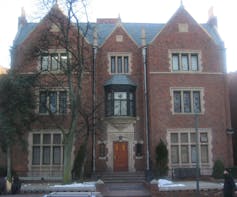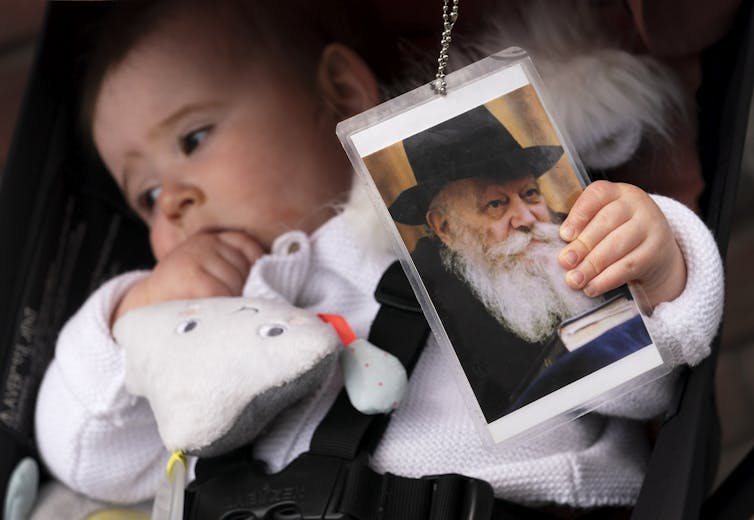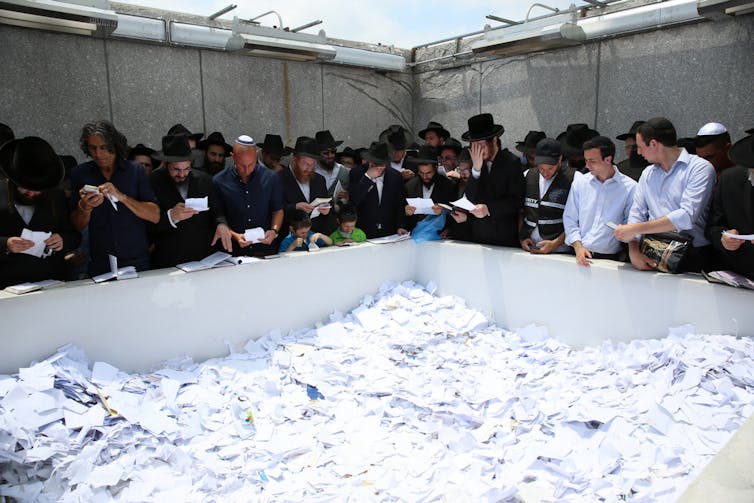What is Chabad-Lubavitch? A Jewish studies scholar explains
The Lubavitch movement, also called Chabad, shares many beliefs and traditions with other ultra-Orthodox Jews. Yet its outreach and beliefs set it apart.

If you live anywhere near New York – or anywhere in the world, really – you may have seen a picture of Rabbi Menachem Mendel Schneerson. Yellow posters of the rabbi’s face are stuck to lampposts or streetlights: an elderly man with a long white beard and black hat.
For tens of thousands of ultra-Orthodox Jews, Schneerson is simply “the rebbe”: the leader of the Chabad-Lubavitch movement, even though he died in 1994. The name “Chabad” is familiar to many Americans, but the actual beliefs of this Hasidic group rarely are.
As someone who was raised in a Lubavitch community and became a scholar of sociology and Jewish studies, I am often asked what sets it apart from other Orthodox streams of Judaism.
Mystic teachings, joyful prayer
Hasidism began under the leadership of the 18th-century mystic and healer Israel ben Eliezer, known as the Baal Shem Tov. Instead of focusing on the Bible and Jewish law, the movement prioritized attaching oneself to God through joyful prayer and passionate devotion.
The Lubavitch sect of Hasidism was founded in the late 1700s by Rabbi Schneur Zalman of Liadi, the author of the Tanya – a theological text and self-improvement manual still studied daily by Lubavitchers. For over a hundred years, the movement was based in the rural town of Lyubavichi, Russia, from which it derives its name.

Since 1940, however, Lubavitch has been based in Crown Heights, Brooklyn. The headquarters there at 770 Eastern Parkway are simply referred to as “770” by Lubavitchers the world over, who imbue the red brick building with mystical symbolism.
Lubavitch, also known by the name “Chabad,” is one of the largest Hasidic groups today, with an estimated 90,000 members.
Lubavitch shares many things in common with all streams of Orthodox Judaism, including a commitment to strictly abiding by “halacha” – Jewish law and customs. The group also shares a great deal with other ultra-Orthodox communities, such as opposition to providing their children with secular education.
Yet there are key features of Lubavitch that distinguish it – particularly how much it engages with non-Orthodox Jews.
The rebbe
All Hasidic sects have a leader, a “rebbe,” who is believed to possess unique spiritual gifts and connect his followers to the divine. Still, Lubavitch is distinct in terms of the extent to which the rebbe is central to the lives of every single member of the community.
In 1951, Schneerson accepted leadership of the Lubavitchers after the passing of his father-in-law and grew the movement exponentially until his passing in 1994. Rather than naming a successor, however, Lubavitchers have continued to regard Schneerson as “the rebbe.”
With his piercing blue eyes, full white beard, black fedora and silk coat, images of Schneerson are ubiquitous among Lubavitchers. Photos and paintings of him adorn walls, key chains, clocks and charity boxes wherever they live.

While the rebbe was alive, his followers would ask him for advice and blessings regarding all spiritual matters, as well as questions about health, business and marriage. Since his passing, followers continue to seek his blessings by placing notes at his gravesite and searching his printed works for guidance.
Even among Lubavitchers who have left the fold, many still feel attached to its leader.
Jewish outreach
One expression of Lubavitchers’ devotion is their commitment to creating Jewish outreach centers all over the world.
The ethos of sharing Hasidic thought was present from the founding of the Lubavitch movement. This drive became much more developed, however, during and after the Holocaust and continued under Schneerson’s leadership.
Today, Lubavitch has established Jewish outposts, called “Chabad Houses,” from Melbourne to Hong Kong and Buenos Aires to Cape Town. These emissaries endeavor to reach out to secular Jews and inspire them to become more religiously observant.

The language surrounding Lubavitch outreach often has a militaristic flavor – for example, its youth movement is named the “Army of God”: Tzivos Ha-Shem, in Hebrew. However, outreach is rooted in the commandment to love one’s fellow Jew and a desire to help them enjoy the Jewish tradition. It is also motivated by a belief that these efforts will help fulfill the biblical prophecy of a Jewish messiah, who will usher in a time of global peace.
These two motivations fortify the nearly 5,000 emissaries sent to far-flung communities around the world, notwithstanding profound obstacles. These include being separated from their families, who tend to live in established Hasidic communities, and being vulnerable to antisemitic attacks.
Messianism
The most distinct aspect of contemporary Lubavitch is its enthusiasm for the coming of the messiah and its assertion that Schneerson is that long-awaited messiah, despite his death.
Messianic hopes and people claiming to be the messiah have appeared at various points throughout Jewish history, often during periods of crisis. In the wake of the devastation of the Holocaust, however, Schneerson made the idea of the messiah’s coming integral to every aspect of Jewish life.
Eventually, most followers came to believe that Schneerson was the righteous redeemer sent by God to usher in the messianic age. While Schneerson did not embrace these proclamations, he insisted that through additional acts of goodness and kindness it was possible to bring about the messianic redemption.
While some outsiders criticized this emphasis, especially claims about the rebbe, the situation became much more fraught after he passed away in 1994. In response to this trauma, a split developed in Lubavitch.

One camp, composed largely of those involved in outreach work and members of long-standing Lubavitch families, argued Lubavitch should stop publicly talking about Schneerson being the messiah since it scared away outsiders. The other camp, largely composed of those who joined the community as adults, claimed that he was still the messiah and was about to return, and that it was vital to tell the world.
To some other Jews, this belief seemed suspiciously close to Christian faith in the second coming of Jesus. Still, many Lubavitchers persist in their messianic beliefs.
The future
This issue still divides some Lubavitchers. Nonetheless, since Schneerson’s passing three decades ago, the movement has increased in size and strength.
The group’s cohesiveness has been aided by creative uses of technology to foster a sense of the rebbe’s continued presence in their lives. For example, the Jewish Educational Media organization regularly produces videos that splice footage of his talks with current visuals to make him feel present in the moment. Lubavitchers have reinterpreted Hasidic texts to fit their current predicament, helping them feel grounded despite his physical absence.
While the precise future of Lubavitch is unknown, the fact that it has managed to weather the storm of the rebbe’s passing and emerged stronger gives his followers hope for the future.
Schneur Zalman Newfield does not work for, consult, own shares in or receive funding from any company or organization that would benefit from this article, and has disclosed no relevant affiliations beyond their academic appointment.
Read These Next
Midlife weight gain can start long before menopause – but you can take steps early on to help your b
What you do in the years leading up to menopause can help counter the natural hormonal effects of aging,…
Who thinks Republicans will suffer in the 2026 midterms? Republican members of Congress
The president’s party almost always loses seats in the midterms. More than two dozen Republican House…
Deepfakes leveled up in 2025 – here’s what’s coming next
After a year of fast advances, deepfakes are entering a new era defined by real-time interaction with…






